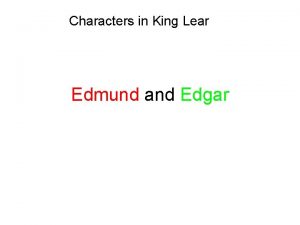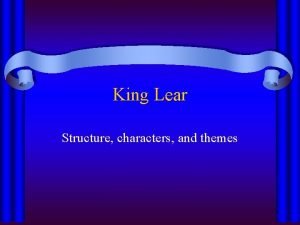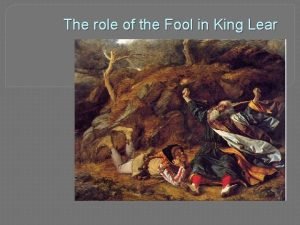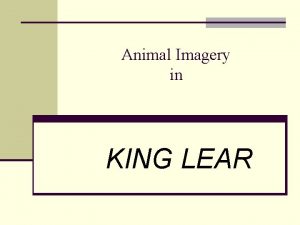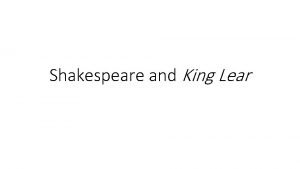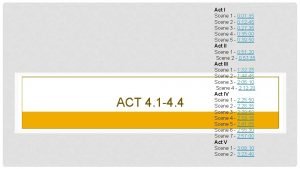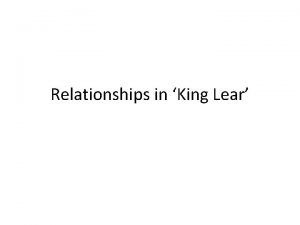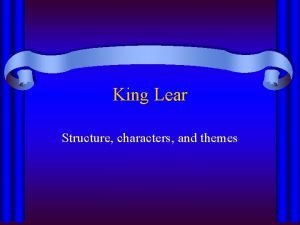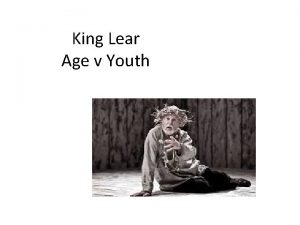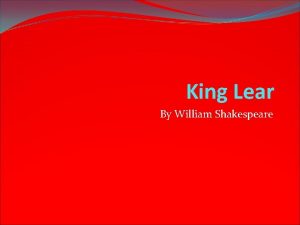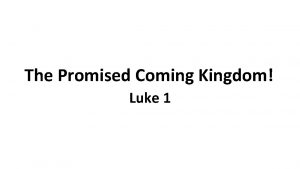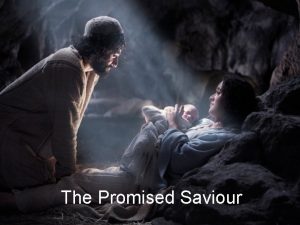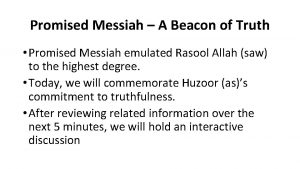Is this the promised end King Lear 5


![• Would not this [his performance of the song], sir, and a forest • Would not this [his performance of the song], sir, and a forest](https://slidetodoc.com/presentation_image_h/edb106d914989385a4f4787ae823dd7f/image-3.jpg)

















- Slides: 20

‘Is this the promised end? ’ (King Lear, 5. 3. 238): The Stagecraft of Shakespeare’s Endings

Prologue: Hamlet’s Jig Why, let the stricken deer go weep, The hart ungalled play, For some must watch, while some must sleep, So runs the world away. (3. 2. 234 -237)
![Would not this his performance of the song sir and a forest • Would not this [his performance of the song], sir, and a forest](https://slidetodoc.com/presentation_image_h/edb106d914989385a4f4787ae823dd7f/image-3.jpg)
• Would not this [his performance of the song], sir, and a forest of feathers, if the rest of my fortunes turn Turk with me, with two Provencal roses on my razed shoes, get me a fellowship in a cry of players, sir?


The Eschatology of Endings (eschatology = a. The department of theological science concerned with ‘the four last things: death, judgement, heaven, and hell’. ) • ‘I would give you some violets, but they withered all when my father died. They say a made a good end’. • Ophelia, 4. 5. 182

The Eschatology of Endings • ‘The world is a stage, life is the play: we come on, look about us, and go off again’. Democritus (4 th. C BC) • God is the ‘Author of all our Tragedies, ’ a playwright who ‘hath written out and appointed what every Man must play’. ‘Death is the end of the Play, and takes from all’. Sir Walter Ralegh, History of the World (pub. 1614)

A Theory of Endings? • Our composition must be more accurate in the beginning and end, than in the midst; and in the end more, than in the beginning; for through the midst the stream bears us. Ben Jonson, Discoveries (pub. 1641) Accurate = 1. Executed with care; careful.

Shakespeare’s Careless Endings? • In many of his plays the latter part is evidently neglected. When he found himself near the end of his work, and in view of his reward, he shortened the labour to snatch the profit. He therefore remits his efforts where he should most vigorously exert them, and his catastrophe is improbably produced or imperfectly represented. • Samuel Johnson, 1765

Theatre as durational art form Like as the waves make towards the pebbled shore, So do our minutes hasten to their end; Each changing place with that which goes before, In sequent toil all forwards do contend. Sonnet 60

The Craft of Endings: some questions and tentative answers • 1) How long does an ending last? Final scene average: 240 lines or c. 16 minutes • 2) What is the average length of the closing speech act? 9. 25 lines • 3) Who speaks it? A male character • 4) What time elapses between the death of a major character and the end of the play? Average = 64 lines

The Craft of Endings: some questions and tentative answers • 5) How many plays end in rhyming couplets? Approx. 75% or three in four • 6) How many plays end with the promise of offstage discussion? At least 14 • 7) How many plays end with an epilogue or a jig? Impossible to say, but 10 epilogues survive in print • 8) When does a performance end? Discuss

The Ending of the Shrew

The new puritanism: • For a variety of reasons theatrical professionals continue to be unsatisfied with the closing moments of Shakespeare’s plays as scripted in the Folio and the Quartos, so that a playgoer is especially likely to encounter some form of rescripting in Act 5. • (Alan Dessen, Rescripting Shakespeare, p. 109)

The theatre’s defence against puritanism: • A production is only correct at the moment of its correctness, and only good at the moment of its success. In its beginning is its beginning, and in its end. Peter Brook

UNEXPECTED ENDINGS…

Conclusions: • Endings in the early modern theatre had a theological dimension • Far from being careless, Shakespeare deliberately experimented with different forms of dramatic (non)closure throughout his career, sometimes providing more than one ending for the same play (e. g. Lear) • Shakespeare often embeds an interpretive injunction at the end of his plays

• The playtext is a radically incomplete form of writing and the performance does not end with language • This incompletion demands that theatrical practitioners exceed the text and shape their own endings • It’s hard to say exactly when the performance ends • [All statistics should be treated with caution and require interpretation]

Henry Irving’s end to Hamlet: Good night, sweet Prince, And flights of angels sing thee to thy rest… Whiles I behind remain to tell the tale Which shall hereafter make the hearers pale.

King Lear – Quarto (1608) Lear. And my poore foole is hangd, no life, why should a dog, a horse, a rat of life, and thou no breath at all, O thou wilt come no more, neuer, pray you vndo this button, thanke you sir, O, o, o o. Edg. He faints my Lord, my Lord. Lear. Breake hart, I prethe breake.

King Lear – Folio (1623)
 Why let the stricken deer go weep
Why let the stricken deer go weep Edmund and edgar
Edmund and edgar Edgar in king lear
Edgar in king lear Terrors of the earth king lear
Terrors of the earth king lear Themes of king lear
Themes of king lear King lear motifs
King lear motifs Fool's speech in king lear
Fool's speech in king lear King lear historical context
King lear historical context Macbeth act 5 scene 2 summary
Macbeth act 5 scene 2 summary Imagery in king lear
Imagery in king lear King lear story
King lear story King lear act 3 scene 6 summary
King lear act 3 scene 6 summary Sight and blindness in king lear
Sight and blindness in king lear King lear act 4 scene 7 summary
King lear act 4 scene 7 summary Weight gain ao4
Weight gain ao4 We cry when we are born shakespeare
We cry when we are born shakespeare On sitting down to read king lear
On sitting down to read king lear King lear questions and answers doc
King lear questions and answers doc King lear and cordelia relationship
King lear and cordelia relationship King lear character quotes
King lear character quotes Going to see king lear jackie kay
Going to see king lear jackie kay

